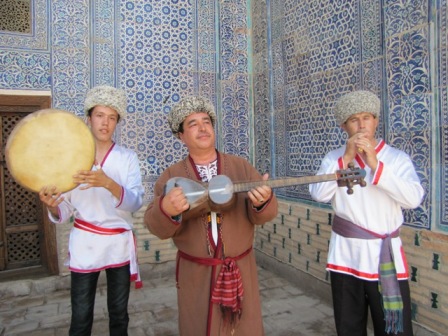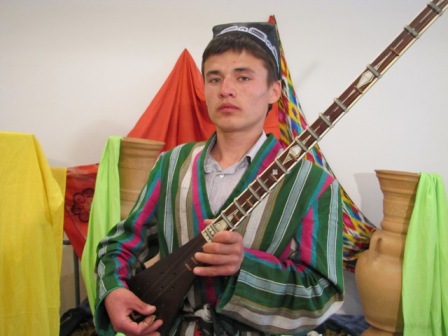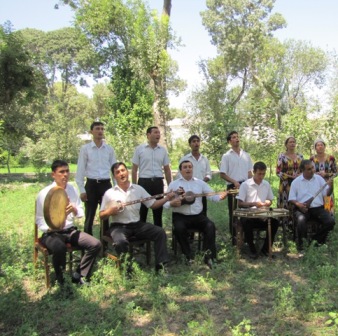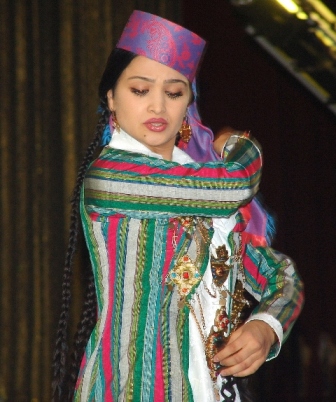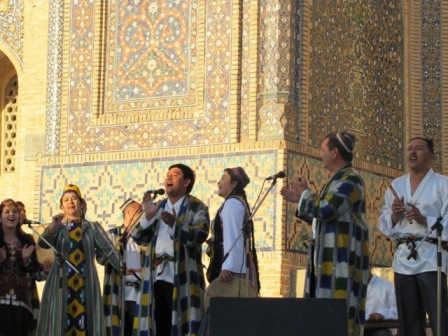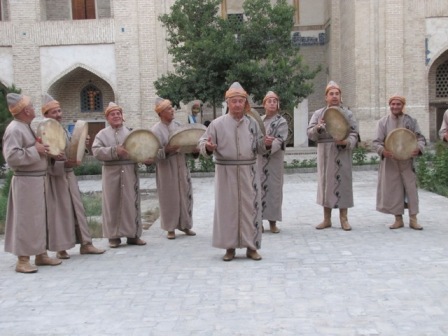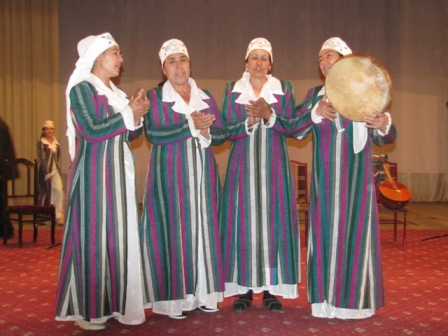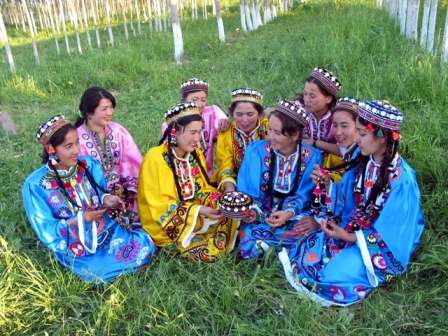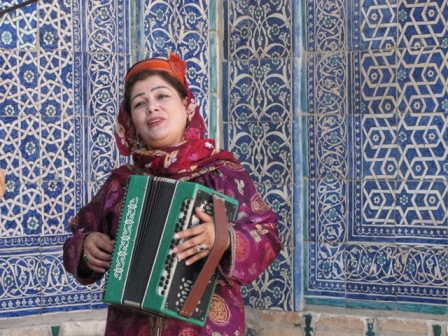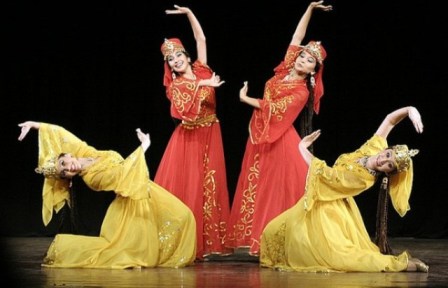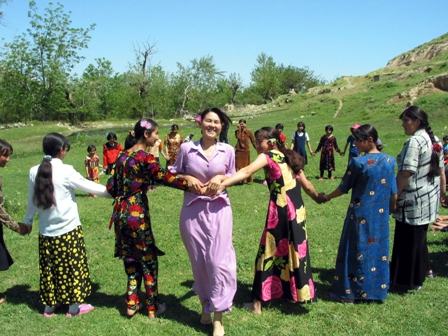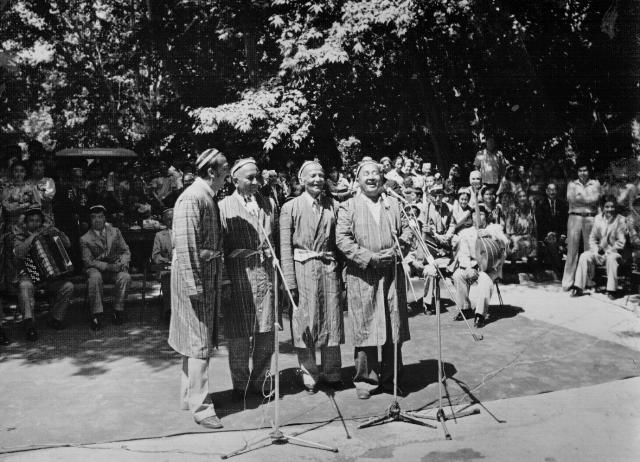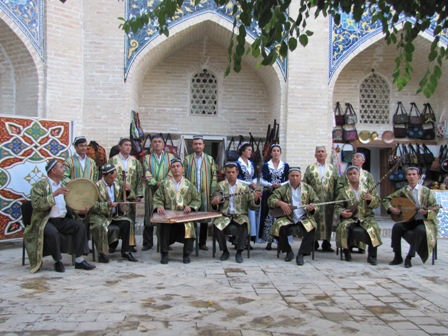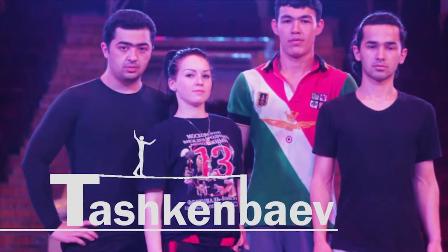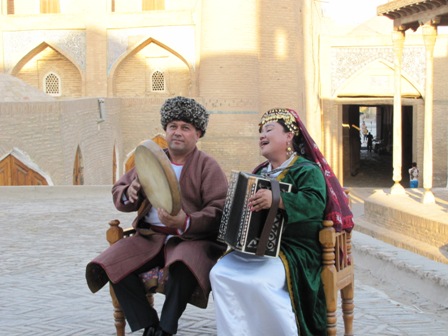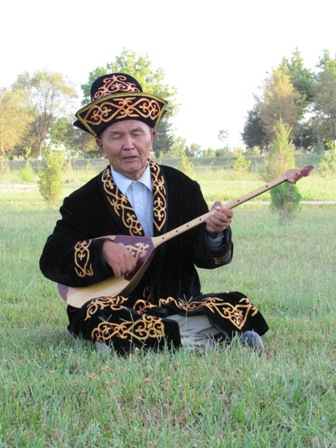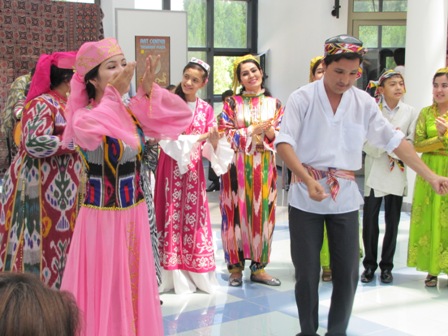|
Domain: Performing Arts
Suvora (in Persian – "a horseman") is a large vocal-instrumental piece, a piece of vocal section (ashula yoli) of the cycle of Khoresm maqoms, which is widespread in Khoresm. In the past it represented one of the types of music art in Sufizm. It was usually performed on the basis of religious texts and its performers were called "guyanda" ("singer"). |
|
Domain: Performing Arts
Naqsh (literally, "an ornament", "a song", "a form") is a song and a lyrical-vocal piece in Uzbek traditional vocal music. In the Ferghana Valley it represents a widely spread wedding and ritual related song-cycle, which is performed by men while seeing off the groom to the house of bride. |
|
Domain: Performing Arts
Developed song genres are widespread in Uzbek vocal art. At the same time, they are diverse in terms content, structure and melos. Typical for them is peculiar manner of singing. For example, they are more lengthy and lyrical, have songful-cantilena intoning and articulation. |
|
Domain: Performing Arts
"Tanovar" (in Persian language – "brave", "strong") is a vocal and instrumental piece, which is widespread in Uzbekistan, in particular in the Ferghana Valley. The word "tanovar" itself is made up of two words, i.e. "tan" – "body", or "soul" and "ovar" – "delight". In other words it can be read as "a delight of soul". |
|
Domain: Performing Arts
Thoughts and hopes of Uzbek peoples, their way of life and customs were brightly reflected in singing art, predetermined thematic and genre diversity of folk songs, which exist in closed socio-cultural environment. Singing art of Uzbek people formed for centuries depending on its social and daily life functions, social and psychological peculiarities of the ethnos. |
|
Domain: Performing Arts
Folklore art, which embodies the traditions of oral singing creativity, has a rich history. This is acknowledged by diverse archaeological findings, works of oriental miniature, etc., which came down to us from the ancient past. Notably, in music culture of Uzbekistan the term "sozanda" (literally – "a musician-instrumentalist") is popular term. However, in Bukhara and nearby areas, since ancient times, this term meant a woman, who was a performer of folk songs and dances or a group of women-singers, which, with its song and dances, participated at wedding ceremonies (mostly in women's circles) and pleased viewers and guests. Interestingly, the art of Bukhara sozandas is considered as one of the major ones in music culture of Uzbekistan. And in their creative activity performance of mavrigi occupied significant place. |
|
Domain: Performing Arts
Uzbeks, who represent one of the nations of the world, have very ancient cultural traditions. These traditions evolved already in antiquity, and since then constantly developed and changed. As a result of this, significant examples of folklore art emerged, that are distinguished by verbal nature, mass character and locality. Each district and each region of Uzbekistan attracts with its distinct genre system as well as peculiarities in performance styles. One of such genres is qarsak, a singing and dancing genre, a certain type of folk game, which was spread in Jizzakh, Samarkand, Kashkadarya and Surkhandarya regions in the past. |
|
Domain: Performing Arts
Rituals and festivities with their diverse customs and traditions occupy an important place in the traditional culture of Uzbekistan. Rituals, much like festivities, incorporate everything which was accumulated in nation's culture throughout centuries, reflect historical life of a certain social and economic formation, and to some extent, shape spiritual world of the people. |
|
Domain: Performing Arts
In Khoresm region of Uzbekistan, a woman-performer of folk songs, folk-epic stories as well as fragments of dostons and their songs is called "khalfa". Khalfachilik, i.e. khalfa art emerged and evolved in Khoresm in the Middle Ages. In the ХIХ-ХХ centuries this art began to show up as a distinct type of women's performance, which was organized in the premises of a house designed for women ("ichkari"). Later on, women-khalfas began to stage their performnces during weddings and folk festivities. |
|
Domain: Performing Arts
Dancing art of Uzbekistan, which unites the traditions of oral folk creativity, songs and dances, has a rich history. This is testified by numerous archaeological findings, artifacts, wall paintings (in the palaces), ossuaries and works of miniature art of the Middle Ages which came down to us from the ancient past (for instance, images of dancing women and men on wall paintings of Tuproq Qala (Karakalpakstan) related to the II –VI centuries; rock painting called "Dancing woman", which were found in Chelak village near Samarkand and which date back to the V century; the dance of religious nature engraved on the stones of Yakkabogh (Kashkadarya region) related to the VII century; miniature of Mahmud Muzahhib called "Dancing women" and several other miniatures created by Kamoliddin Bekhzod, the brightest painter of Bukhara school of the ХV-ХVI centuries; names of the dancers in the works of Alisher Navoi from the ХV century, etc.). |





